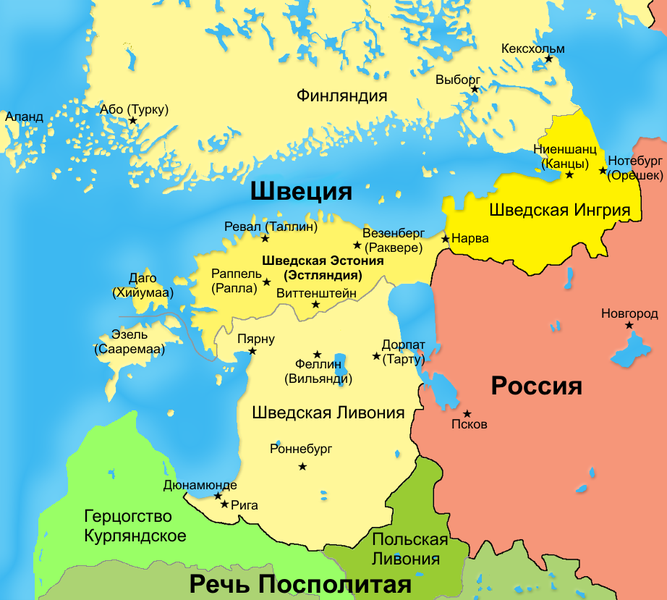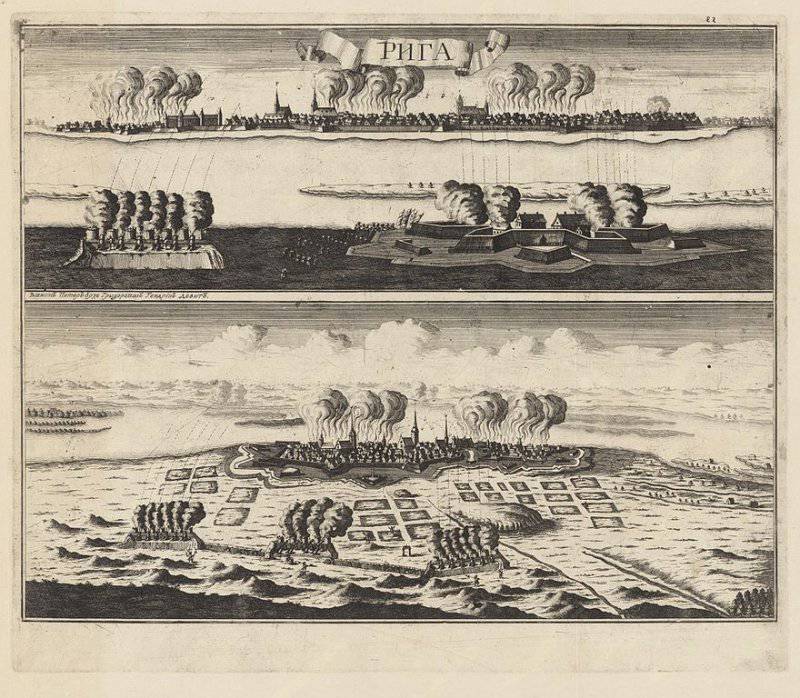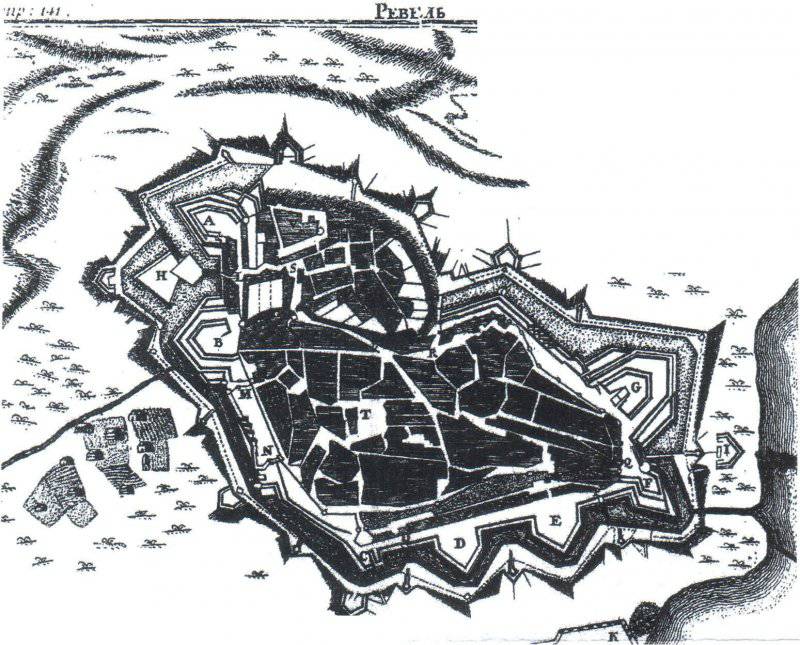Baltic campaign 1709-1710's.
Sweden did not go to peace talks. The Swedes had a powerful navy and enough land forces to try to keep their possessions in the Baltic States. Karl XII even cherished plans for new campaigns of conquest and answered all proposals for peace negotiations with a categorical refusal. It took another long 12 years of bloody war for the Swedish elite to declare themselves defeated.
The former allies of Russia - Saxony, Poland and Denmark grew bolder and decided to resume the struggle in alliance with Moscow against the Swedes. Peter undertook all the difficult diplomatic activities to renew the union and prepare for the interaction of the armed forces of the states. 8 August 1709, the Saxon Prince Augustus broke the Altranstedt agreement with Sweden and expressed his claims to the Polish throne. His 15 thousand army moved to Krakow. From Russia, the Menshikov corps was sent to Poland. In such conditions, the Polish detachments, which remained loyal to Stanislav Leschinsky, and the Swedish parts of Crassau were forced to retreat from Poland to Pomerania. September 26 (October 7) in Torun, Peter met Augustus II. 9 (20) October, a new treaty was signed between Russia and Saxony, he restored the defensive and offensive alliance between the countries. Augustus was proclaimed king of Poland.
Denmark joined the union, trying to take advantage of the favorable military-political situation and return the positions lost at the beginning of the Northern War. 11 (22) October, the Russian ambassador to Denmark, Prince V. L. Dolgoruky, signed a treaty of alliance with Copenhagen. It was a strong ally. Denmark in 1709 had a strong army and fleet as part of the 40 battleships and 10 frigates. The Danes promised that in the fall of 1709, they would launch an offensive on land and at sea, doing everything possible to capture Skoniya (it was a Swedish province in the very south of the Scandinavian Peninsula). Russia pledged to strike at Finland. In addition, the Northern Union was strengthened by other powers - Prussia and Hannover concluded a defensive alliance against Sweden with Russia. The difficult years, when Russia had to confront the Swedish Empire alone, ended, a powerful alliance came out against the Swedes.
In the middle of July, 1709, a military council was held in Reshetilovka. It was decided that the gravity of the hostilities had to be transferred to the Baltic States and knock out the Swedes from there. The main part of the army under the command of Sheremetev (40 thousand people) was sent to Riga.

Siege of Riga
At the beginning of the 18 century, Riga was one of the most powerful fortresses in Europe with a castle and a citadel. Powerful walls surrounded Riga, the fortress had 5 bastions, 2 ravelin and 2 a trench, there was a moat in front of the fortifications. In addition, in front of the fortress there was a forstadt (suburb of the city), protected by an earthen wall and palisades. On the opposite bank of the Zapadnaya Dvina was located the Kobronshants fort, which covered the floating bridge across the river, it was reinforced by four bastions and one semi-bastion and was also surrounded by a moat. The armament of the fortress was 563 guns, 66 mortars and 12 howitzers. The garrison consisted of 14,4 thousand people, plus armed townspeople. The command was carried out by the Governor-General of the Swedish Estland in 1706 - 1709 years Nils Stromberg.
To take such a stronghold, it was necessary to have a strong army, a significant amount of artillery, ammunition, equipment, food and fodder. The command had to make significant efforts to organize such an operation. Thus, in the upper reaches of the Western Dvina, river vessels were being prepared, which transferred part of the troops and supplies necessary for the siege. Even the movement of the Russian army from Ukraine to the Baltics was a difficult task. Polish territory was already ravaged by war, so it was difficult to get food. Rains, mudslides, off-road greatly slowed the progress of the army. As a result, the concentration of troops near Riga dragged on. By early October, the army pulled up to the fortress Dinaburg (Dvinsk). Three dragoon regiments led by General A. G. Volkonsky were sent to Kurland for reconnaissance. 5 (16) of October Sheremetev sent four dragoon regiments led by General Rodion Christianovich Bour to explore in Livonia, they were strengthened by Don Cossacks Ataman Mitrofan Lobanov.
15 (26) October, Russian troops entered the territory of Livonia and Courland. By October 27 (November 7) the transfer of troops was completed. Riga was blocked, its siege began. Even before the arrival of the Russian troops, General Stromberg ordered to destroy the floating bridge over the river and leave Kobronshants, brought the forces there to Riga. Kobroshants occupied the Russian troops and installed an artillery battery there. These guns could fire at Riga and the fairway of the river. On the right bank of the river, in 7 km above Riga, a bridge and bridgehead was built. In order to prevent the post of Riga and Revel, two dragoon regiments and three hundred Cossacks were stationed in Novy Mlyn. Simultaneously, work began on the construction of fortifications and artillery positions on the banks of the Zapadnaya Dvina river between Riga and the Dinamünde fortress (Ust-Dvinsk). They were supposed to prevent the Swedes from breaking through from the sea. 10 (21) November, Peter arrived at Riga. The king appreciated the situation and decided that it was not worth to storm it, a close blockade was needed. 14 (25) November began bombardment of the fortress. To carry out the blockade and the shelling of the fortress was left 6 thousand detachment under the command of Anikita Repnin. The remaining troops were assigned to winter apartments in Livonia, Courland and Lithuania. Peter left for St. Petersburg in November, and Sheremetev left for Moscow in December.
By December 2 (13) siege works were completed. Heavy artillery arrived, it was located in Kobroshan, and this dramatically increased the capabilities of the besieging party. Russian artillery destroyed many buildings in the fortress. 12 (23) December caught fire and exploded the tower of the Riga citadel, there was located a bomb equipment workshop and a powder magazine. The fire and explosion were of such strength that not only destroyed significant stocks of gunpowder and ammunition, but also led to the death of more than 1 thousand people.
In the spring of 1710, the Russian army increased the blockade of Riga. 11 (22) March Sheremetev returned to the army. The construction of batteries on the Western Dvina between Dinamünde and Riga was completed. They were armed with 32 guns, their garrison was 700 grenadiers and soldiers, as well as 300 Cossacks. They had boats to carry watch on the river. They began to build another fortification at the Gofemberg tract, it was called Aleksandrshants. The Russian command attached great importance to the suppression of the communication of Riga through the Western Dvina. In addition, there was a danger that the Swedes would try to unlock the fortress from the sea, climbing up the Western Dvina. Menshikov and Sheremetev decided to build not only a new fortification, but also a pile bridge over the river, blocking the river in front of the bridge with connected chains of logs. On the shore at the ends of the bridge were going to install artillery batteries. These measures were not an empty precaution. Already on April 28 (May 9), nine Swedish marques attempted to break from Dinamünde to Riga, but were repulsed by artillery fire.
By 29 of April (10 of May) the entire Russian army was concentrated at Riga. The division of Ludwig Allart is located directly in front of Riga. The division of A.D. Menshikov was stationed in the area of Aleksandrshants and the new bridge, the division of A.I. Repnin was higher than Riga. The positions of Allart and Menshikov's divisions were reinforced by new fortifications - the Russian command still feared a strike from Dinamünde and Pernov. Peter, stationed in St. Petersburg, more than once pointed to such a danger, believing that an unexpected Swedish landing party could nullify all the successes of the Russian army in the Riga region. Thus, on May 27 (June 7), the Russian command commissioned the intelligence information that the Swedes were going to transport an 20-thousandth corps from Scone, commanded by General Steinbock, to unlock Riga. In addition, it should strengthen 6-7 thousand detachment of General Krassau. To carry out this operation, the Swedish command planned to mobilize the entire military and transport fleet, to hire foreign ships. The Russian military council, discussing this information, decided that if the enemy landed at Dinamünde, meet him with all the main forces and give battle, leaving a minimum of troops in the fortifications at Riga. In the event that the Swedes landed troops in Pernov, as in 1700, when Karl moved the army to Narva to meet the enemy at Novy Mlyn.
The 10 (21) of May to Riga arrived siege artillery, led by General Bruce. Everything was ready to strengthen the siege of the fortress and its future assault. Already prepared the assault ladder to overcome the walls and shafts. But contingency increased the time of the siege. 14 (25) in May began a plague epidemic, apparently brought from Kurland from Prussia. She claimed the lives of 10 Thousands of Russian soldiers. The inhabitants of Riga suffered huge losses. According to some reports, famine and plague have claimed up to 60 thousands of lives of the people of Riga. The epidemic forced the Russian command to postpone the assault, decided to conduct only a private operation - to seize the suburbs of the city and install closer to the fortress battery mortars. On the night of May 30-31 (June 10-11) 2,4, a thousand detachment of brigadier Shtaf and Colonel Lassi, with a battle, broke into the suburb and captured it. New engineering works were deployed, three batteries of mortars were deployed in the suburb - 14 units. The position of the Swedish garrison deteriorated further.
The Swedish command tried to help the garrison - a Swedish squadron from 24 pennants arrived at Dinamünd. Her appearance caused great joy in Riga. The Swedes tried to break up the river to Riga. But all attempts were reflected by the fire of batteries. Only three ships 9 (20) of June were able to break through to Riga, but even here they were met by artillery fire and forced them to retreat. Soon the Swedish squadron left the sea altogether and did not appear again. As a result, the fortification system built between Riga and Dinamünde on Peter’s instructions played a positive role.
Sheremetev offered to capitulate to the commandant of the fortress Stromberg, but he refused, still hoping for outside help. An intensified bombardment of the city began: from 14 (25) to 24 June (5 July) to Riga, 3389 shells were fired, which caused significant destruction. The Swedish garrison asked for a truce for 10 days. Sheremetev gave two days to think. Stromberg was pushed to the negotiations not only by the sad position of the garrison of the fortress, but also by the strong pressure of representatives of the Riga nobility, city elite and clergy. They understood that the fall of Riga was inevitable and began not only to put pressure on the commander of the garrison, but even agreed to an agreement with Sheremetyev. The nobles and the magistrate were ready to capitulate if they retain their rights and liberties.
4 (25) July 1710 of the year Riga surrender was signed. All the artillery of the fortress went to the Russian army. A little more than 5 thousand people were taken prisoner - the remnants of the garrison, most of them were sick. Moreover, the garrison was initially promised to be released, but then part of the Swedes, under Peter’s orders, were detained as honorary prisoners in order to be exchanged for soldiers captured near Narva in 1700. For example, Stromberg was exchanged for the Russian commander Adam Adamovich Veyde. On the same day, in the presence of Sheremetev and the entire Russian generals, Ingermanland, Kiev, Astrakhan, Siberian, Kazan and Butyrsky regiments solemnly entered Riga through the Sand Gate. 12 (23) July Sheremetev took the oath from the Livonian clergy, nobility and merchants.
It was a big success. Peter wrote to Sheremetev that the seizure of Riga is equal in value to Poltava.
Taking Dinamünde. After the fall of Riga, the fate of Dinamünde was resolved. It was an old fortress that controlled the mouth of the Western Dvina River. By the beginning of the Northern War, the Swedes had rebuilt the fortress: the earthen structures were replaced with stone ones, six bastions and five raelins were built. 6 (17) July at the Russian military council, it was decided to take the fortress. The position of the Russian army was facilitated by the fact that a plague began in the fortress, almost the entire 1,2 thousand garrison was simply extinct. Most of the 700 reinforcements died from the plague. The Russian command possessed this information, intercepting the letter of Commandant Dinamünde K. Stackelberg to Riga. 2 was sent to the fortress by a thousand detachment of General Buk with several guns and mortars. He blocked the fortress and offered to capitulate to the commandant. But the Swedes refused. A battery was installed from 9 (20) on 10 (21) in July, and shelling began. A fortification was built at the mouth of the river to cut off the fortress from the sea. In addition, another redoubt was built on the island, where the Swedish fortress itself was located. As a result, the Swedes were blocked from all sides. Attempts by Swedish ships to approach Dinamünde were reflected by artillery fire. The Swedes were in a hopeless situation. 8 (19) August Shtakelberg capitulated. The fortress was captured 198 guns, 14 mortars, 13 howitzers.
Capture Pernova (Pärnou). The next operation was the capture of Pernova. 13 (24) July, Peter ordered the cavalry led by Bour to be sent to Pernov to block it. Cavalry gave a few guns to strengthen the blockade. On July 22 (August 2), the siege of the fortress began, and already on August 14 (25), Pyarno surrendered. 183 cannons, 14 mortars, 4 howitzers and other military assets were captured in the fortress.
After that, Russian troops occupied the island of Ezel. The Ahrensburg fortress located there was occupied without a fight. The fortress captured 66 guns and 4 mortars.
The fall of Revel. General Bour left the garrison in Pernov and went to Revel. It was the last stronghold of Sweden on the southern shore of the Baltic Sea. This city was of strategic importance. His fall led to the fact that the Swedish command lost the opportunity to transfer troops by sea from Sweden to the Baltic States. The garrison was 4,5 thousand people.
Back in December 1709, the commandant of Narva, Colonel Zotov, received an order to start moving towards Revel and made three regiments of dragoons. Began a flight of the local population in the city. By August 1710, Zotov approached Revel and settled near the so-called. Upper Lake - the main source of fresh water for the citizens. The channel from the reservoir to the city was immediately closed. Soon the population and the garrison felt the brunt of the siege. Not enough water, food, epidemics began. 11 (22) August was the first case of the plague. The 15 (26) of August six infantry regiments under the command of Brigadier Ivanitsky arrived at Revel. 18 (29) in August, cavalrymen led by A. Volkonsky and then Bour's compound approached the city. The blockade has become even more powerful, but before the bombing and assault it did not come. Peter promised to keep the citizens of their religion, old privileges, all rights and freedoms. In addition, the morale of the population and the garrison was undermined by reports of the fall of Riga and Pernov, the plague epidemic. The German nobility and merchants decided that the victory of Russia in the war is inevitable, therefore, we must find a common language with Peter. They put strong pressure on the garrison command. The September 29 (October 10) garrison capitulated. The Swedes got the right to evacuate to Sweden.
The 1709-1710 campaign in the Baltics was completed with a complete victory for Russia. The Swedes were expelled from Livonia (Latvia) and Estland (Estonia). Russia captured strategically important fortresses and the cities of the Baltic states - Riga, Pernov, Revel. Sweden has lost the opportunity for landing troops in the Baltic States and supporting bases for the conduct of an offensive war.
Revel 1710 Plan of the Year, "The Book of Mars".


Information